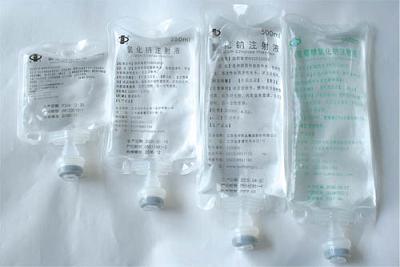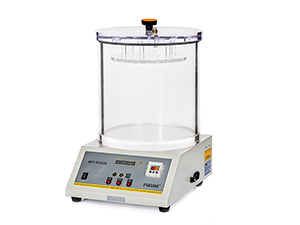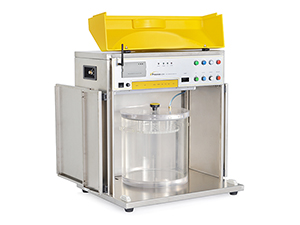Summary
The medicinal infusion bags are mostly made of a composite film formed by co-extruding polyolefin and polyamide resin materials as packaging materials, which have the advantages of high hygienic safety, no precipitation particles, high barrier property, and not easy to be broken, but the sealing property thereof. Good or bad is the performance index that most affects the quality of the liquid and destroys the sterile environment. This article adopts
Labthink
Languang independently developed
MFY-01
The sealing tester detects the sealing performance of the infusion bag, and details the testing principle and detailed test process of the instrument, which provides reference for the pharmaceutical industry and other industries in the monitoring of the sealing performance of the infusion bag.
Key words
: infusion bags, pharmaceuticals, pharmaceuticals, soft plastic packaging, sealing properties, seal tester, leaks, leaks, air bubbles
1
,significance
Medicinal infusion bags include polyvinyl chloride (
PVC
) material and non
PVC
Composite film material, most of the current use of non
PVC
A three-layer or five-layer co-extruded composite film made of a composite film, the main material of which is polypropylene (
PP)
Polyethylene
PE)
Polyamide
PA
) and a variety of elastic materials (
SEBS
), is one of the safest infusion packaging materials at present, does not contain any plasticizer, and has no reaction or adsorption between itself and the liquid medicine. It eliminates the problem of alkali precipitation of glass bottles and has good low temperature resistance. High quality materials.
The good quality pharmaceutical infusion bag should not be easily broken, its gas barrier property and water resistance are high, and the internal liquid solution is not easy to deteriorate or leak, which can meet the demanding aseptic environment. However, the medicinal infusion bag relies on heat sealing to seal the sealing edges around it, and the heat sealing parameter is not suitable in the heat sealing process, which causes the heat sealing to be not tight or the heat sealing is excessive. For example, if the heat sealing temperature is too high, the sealing is caused. The root is prone to breakage or gas leakage, or the surface of the heat sealer is not flat, resulting in the edge of the seal wrinkles containing leak points that are not sealed. If the sealing property of the infusion bag is not good, the water vapor, oxygen and other gases in the external environment will easily penetrate into the inside of the infusion bag, causing bacteria to invade, causing deterioration and oxidation of the drug solution, and even leakage during transportation or use. This article uses a professional sealing performance tester to introduce relevant test solutions for the sealing performance of infusion bags to relevant pharmaceutical manufacturers.

Figure
1
Medicinal infusion bag packaging
2
,standard
At present, the main reference of the sealing performance test of soft plastic packaging
GB/T 15171-1994
"Test Method for Sealing Performance of Flexible Packages", which is applicable to the sealing performance test of sealed flexible packages made of various materials.
3
Test sample
A brand of sodium chloride infusion bag finished packaging.
4
Test equipment
This article adopts
Labthink
Languang independently developed
MFY-01
The seal tester tests the sealing performance of the infusion bag sample.

Figure
2 MFY-01
Seal tester
4.1
Test principle
MFY-01
The sealing tester determines the sealing performance of the sample by observing the pressure difference between the inside and the outside of the sample immersed in the water by vacuuming the vacuum chamber, thereby determining the sealing performance of the sample; or by adding water without The vacuum chamber is evacuated to make the sample have a pressure difference between the inside and the outside, and the shape of the sample is recovered after the sample is expanded and the vacuum is released, thereby determining the sealing performance of the sample and accurately finding the position where the sample is prone to leakage.
4.2
Scope of application
l
This equipment is suitable for packaging bags, bottles, tubes, cans, boxes and other closed products made of glass, plastic, metal materials, etc. in the pharmaceutical, food, medical equipment, daily chemical, automotive, electronic components, stationery and other industries. The sealing performance test is also applicable to the test of the sealing performance of the sample after the test such as drop, pressure, high temperature or cooking.
l
This device complies with a number of national and international standards, such as
GB/T 15171
,
ASTM D3078
Wait.
4.3
Device parameters
l
Vacuum degree is
0 ~ -90 KPa
.
l
The effective size of the vacuum chamber is
3
Available as a choice
270 mm (
diameter
) × 210 mm (
height
)
,
360 mm (
diameter
) × 585 mm (
height
)
,
460 mm (
diameter
) × 330 mm (
height
)
.
l
The system uses digital preset test vacuum and vacuum hold time to ensure the accuracy of test data.
l
use
The automatic constant pressure air supply technology further ensures that the test can be carried out under preset vacuum conditions.
l
Professional software supports automatic backflush unloading and automatic end-of-test functions to ensure a smooth test process.
5
,experiment procedure
(1)
An appropriate amount of distilled water was placed in a vacuum sealed can (i.e., a vacuum chamber), and the infusion bag sample was immersed in water. At this time, the distance between the top of the sample and the water surface must not be lower than
25 mm
.
(2)
Cover the sealing cover to ensure that there is no air leakage around the sealing cover and the sealed can is sealed well.
(3)
The test parameters such as the vacuum degree (ie, the negative pressure value) required for the test and the dwell time in the vacuum tank are set through the microcomputer operation interface.
(4)
Turn on the vacuum pump and click the test button to start the test.
(5)
Observe the process of vacuuming and holding pressure
The leakage of the sample was observed to see if there was continuous bubble generation.
(6)
If there are continuous bubbles on the surface of the sample, record the pressure value at which the continuous bubble appears and the position at which the bubble is generated.
(7)
Close the vacuum pump, open the vacuum chamber to the atmosphere, open the sealing cover, take out the sample, wipe the surface water, and if necessary, open the seal to check whether there is test water infiltration inside the sample.
(8)
Turn off the instrument.
6
,test results
This test was tested altogether
5
A sample of blister packs, none of which is at the highest negative pressure -
90 KPa
There is a leak phenomenon underneath, which has a good sealing property, which can ensure the quality of the liquid medicine is not affected by external bacteria or air.
7
,in conclusion
The tightness of the medicinal infusion bag is the most important performance indicator to ensure that the drug solution is not contaminated and does not deteriorate.
MFY-01
Seal tester
Labthink
In monitoring this performance, it has the advantages of high accuracy, easy operation, tight sealing, etc. It can not only determine the position where the package is prone to air leakage, but also establish the quantitative limit of product quality, thus assisting the improvement of the product packaging process. In order to overcome the shortcomings of the traditional seal tester manual recording test results, the risk of transcription errors, data storage difficulties, difficult to access, poor traceability, etc.
Labthink
Lan Guang at
MFY-01
Based on the improvement of the seal tester, the company developed
i-Process 6200
Sealing tester and data processing system, the system is professionally used for detecting the sealing performance of on-site products. It can automatically judge whether the test results are qualified or not. The test data can be automatically uploaded to the data management center for data management and storage. Management and control of the sealing performance of product packaging on the production site.

Figure
3 i-Process6200
Seal tester and data processing system
In addition to the sealing performance, the heat-sealing strength, puncture resistance, water vapor transmission rate and oxygen transmission rate of the medicinal infusion bag are also important performance indicators of the product. You can log in the corresponding testing equipment.
View or call
0531-85068566
advisory. The more you understand, the more you trust!
Labthink
Languang is looking forward to enhancing technical exchanges and cooperation with enterprises and institutions in the industry!
How does TFT work?
TFT is the abbreviation of "Thin Film Transistor", generally refers to thin film liquid crystal displays, but actually refers to thin film transistors (matrix)-can "actively" control each independent pixel on the screen, which is The origin of the so-called active matrix TFT (active matrix TFT). So how exactly is the image produced? The basic principle is very simple: the Display Screen is composed of many pixels that can emit light of any color, and the purpose can be achieved by controlling each pixel to display the corresponding color. In TFT LCD, backlight technology is generally used. In order to accurately control the color and brightness of each pixel, it is necessary to install a shutter-like switch after each pixel. When the "blinds" are opened, light can pass through, and " When the shutters are closed, light cannot pass through. Of course, technically, it is not as simple as the one just mentioned. LCD (Liquid Crystal Display) utilizes the characteristics of liquid crystals (liquid when heated, and crystallized into solid when cooled). Generally, liquid crystals have three forms:
Smectic liquid crystal similar to clay
Nematic liquid crystal resembling a fine matchstick
Cholestic liquid crystal
The liquid crystal display uses filaments, and when the external environment changes, its molecular structure will also change, and thus have different physical properties-it can achieve the purpose of letting light through or blocking light-which is just like the blinds just now.
Everyone knows the three primary colors, so each pixel on the display screen needs three similar basic components described above to control the three colors of red, green, and blue respectively.
The most commonly used one is twisted nematic TFT LCD (Twisted Nematic TFT LCD). Existing technologies vary greatly, and we will cover them in detail in the second part of this article.
There are grooves on the upper and lower layers. The grooves on the upper layer are arranged longitudinally and the grooves on the lower layer are arranged horizontally. When no voltage is applied to the liquid crystal in its natural state, the light emitted from the light emitting layer of the twisted nematic TFT Display working principle diagram of Figure 2a will be twisted by 90 degrees after passing through the interlayer, so that it can pass through the lower layer smoothly.
When a voltage is applied between the two layers, an electric field is generated. At this time, the liquid crystals are aligned vertically, so the light will not be twisted-the result is that the light cannot pass through the lower layer.
(2) TFT pixel structure: The color filter is divided into red, green, and blue according to the color, which are arranged on the glass substrate to form a group (dot pitch) corresponding to a pixel. Each monochromatic filter is called It is a sub-pixel. In other words, if a TFT display supports a maximum resolution of 1280×1024, then at least 1280×3×1024 sub-pixels and transistors are required. For a 15-inch TFT display (1024×768), then a pixel is about 0.0188 inches (equivalent to 0.30mm), for an 18.1-inch TFT display (1280×1024), it is 0.011 inches (equivalent to 0.28mm) .
As we all know, pixels are decisive for the display. The smaller each pixel is, the larger the maximum resolution that the display can achieve. However, due to the limitation of the physical characteristics of the transistor, the size of each pixel of the TFT at this stage is basically 0.0117 inches (0.297mm), so for a 15-inch display, the maximum resolution is only 1280×1024.
Tft Lcd Module,Lcd Liquid Crystal Display Module,Lcd Module,Lcd Screen Module
Shenzhen Newvision Technology Co.Ltd , https://www.newvisionlcd.com